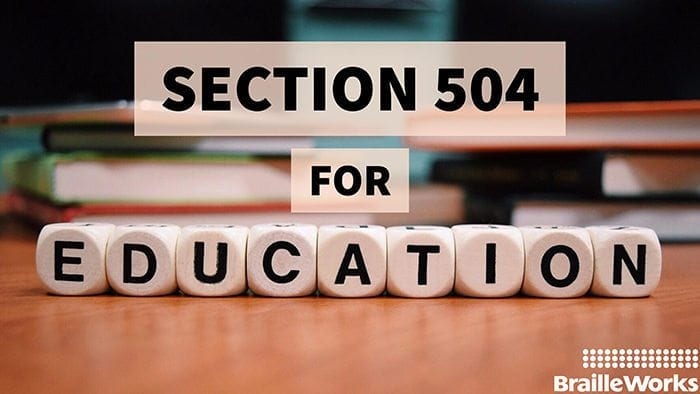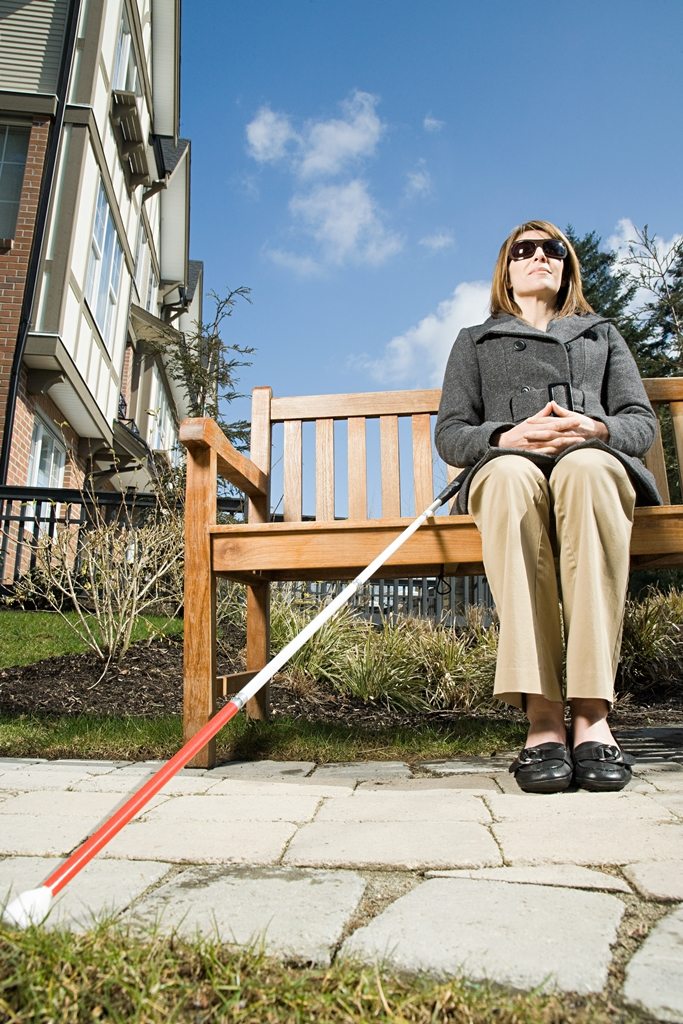Everything Employers & Educators Need to Know About Section 504
Published onWhat is Section 504?
Does Section 504 cover consumers and clients?
How does Section 504 relate to employment?
How does Section 504 apply to education?
Many laws are specific about providing services for people with disabilities, and sometimes it’s hard to make heads or tails of them all. One thing is for sure; these laws are here to stay, and they are creating a brighter future for millions of people. Here is an overview of one such law, Section 504 of the Rehabilitation Act.
What is Section 504?
Section 504 is part of the Rehabilitation Act of 1973, and the Office of Civil Rights (OCR) of the Department of Justice (DOJ) supply oversight and rulings. However, each state is required to also assign agencies to govern and regulate the compliance of Section 504.
Many assume that Section 504 only deals with employment and education. But, did you know that it covers more than that? The Rehabilitation Act was originally created to help veterans with disabilities returning from war. It ensured that they’d have the opportunity to be gainfully employed and educated.
The Rehabilitation Act is inclusive of all persons with disabilities.
Does Section 504 cover consumers and clients?
No, Section 504 only pertains to federally funded programs and a few agencies. However, the Americans with Disabilities Act (ADA) is the catch-all law that relates to other public and private sectors. Any way you look at it, one law or another covers accessibility and equality.
Section 504 requires programs receiving federal funds, federal agencies, and the US Postal Service to give equal access to goods, services, and information for people with disabilities.
What qualifies a person as having a disability?
Defined in 1974, a person with a disability has a mental or physical impairment, which substantially limits one or more of that person’s major life activities. A formal disability diagnosis is not always necessary. When a person has limitations that majorly affect the activities of independent daily living. Examples of these are: caring for one’s self, walking, seeing, hearing, speaking, breathing, working, performing manual tasks, and learning.
How does Section 504 relate to employment?
Section 504 applies to persons with disabilities eligible for employment. These people meet the qualifications for having a disability and, with reasonable accommodation, can perform the functions of the job. The employer is reasonable for accommodations unless it causes a verifiable, and undue financial hardship.
Warning to employers; the courts and DOJ are likely to side with the person who is disabled because many typical accommodations are reasonable. The Job Accommodations Network (JAN) can help organizations better understand Section 504 and ADA accommodations.

Reasonable workplace accommodations
Accommodations will vary for each person based on specific needs; however, the workplace must be accessible for a person with a disability. An accessible workplace might include providing an alternative to print documents such as a reader, an interpreter, or accessible digital devices.
Other reasonable accommodations in the workplace include modifications to tasks, work schedules, and duties. The United States Department of Labor offers examples of reasonable accommodations, but notes there are other accommodations or modifications.
Section 504 and Section 508 working together
Section 508 of the Rehabilitation Act includes specifics about accessibility in the workplace for Information and Communication Technology (ICT). All systems must be accessible to people requiring screen readers.
Did you know that ICT is an all-encompassing category for hardware, software, websites, web applications, PDF, attachments, kiosks, and intranet? These platforms must be accessible to employees with disabilities.
How does Section 504 apply to education?
Section 504 for education is broken up into two areas: Elementary & Secondary as one area, and Post–secondary (college, university, technical training) as the other.
What are the requirements under Section 504 for Kindergarten through High School?
Section 504 for school-age children differs greatly from post–secondary if the school receives any federal funding. School-age children who have an identified disability are entitled to a Free and Appropriate Education, otherwise known as FAPE.
Section 504 of the Rehabilitation Act and the Individuals with Disabilities Education Act (IDEA) must adhere to FAPE. A child does not have to have an Individual Education Plan (IEP) to use FAPE, accommodations, and related services under Section 504.
Many considerations for students with disabilities
Education services need to meet the needs of students with disabilities as adequately as the needs of non-disabled students. It is also essential to keep students with disabilities in a similar or the same setting as non-disabled peers when possible.
Appropriate placement
Each student needs to have an evaluation to find their needs. The placement of the student is vital to their success in education. The program must not exclude a student with a disability from fully taking part if non-disabled peers can participate.
A regular re-evaluation should occur to determine if placement and accommodations are fitting. An adjustment to services and accommodations is often the result of re-evaluations.
If a disability is suspected, the school is responsible for meeting the needs of the student and providing accommodations, regardless of a diagnosis.
Due Process
In the US, we expect that the rights in our laws will be applied to us fairly. This expectation is due process. You are DUE the PROCESS of hearings or legal proceedings before any decision is made.
Each state is required to establish a due process system for parents and guardians. The system must include regular notices, a review of their child’s records, updates on progress and challenges, and inclusion in placement decisions. Due process procedures must include an opportunity for parents to participate, representation by counsel, and a review procedure.
Post-Secondary Education
Section 504 guidelines for post–secondary education are like those for employment. A student cannot be denied participation in an educational program based on his or her disability if they meet the other requirements for admission and participation.
Reasonable accommodations in education remove barriers to allow for effective communication, promote and permit learning, and equal access to services, programs, and information. Accommodations, modifications, and aides are free to the student. These are the tools and methods that allow for equal participation and access to educational services and provisions.
Post-secondary education does not need to be free to people with disabilities. However, a student with a disability cannot pay more than a non-disabled peer for an educational program or housing.
What are the responsibilities of a student in a post-secondary educational setting?
Unlike the requirements for K-12 schools, post-secondary students must make the school aware of their needs. Students with disabilities must inform the school of the accommodations, services, and modification that they require.
There is no IEP, nor does a team meet to decide the proper accommodations. The accommodations and modifications are between the student and the department that services students with disabilities.
FAPE does not apply in post–secondary programs, either. But, appropriate academic modifications and accommodations are the responsibility of post–secondary programs. These accommodations ensure equal access to education.
Students should educate themselves on how to advocate for their individual needs. The U.S. Department of Education has many well written and easy-to-understand guides.
What are the responsibilities of a post-secondary program?
The post–secondary educational facility has to follow federal and state laws by providing equal access to services, programs, resources, and activities.
The U.S. Department of Education and the Office of Civil Rights outlines reasonable and appropriate accommodations for post–secondary students, based on one’s individual needs. These include auxiliary aids and services, and modifications to academic requirements as necessary to ensure equal educational opportunity.
Braille, large print, audio, digital devices, a reader, an aid, hands-on demonstration and more are examples of these aids.
Seven examples of accommodations and modifications:
- Arranging for priority registration
- Reducing a course load
- Providing extended time for the completion of course load and tests and quizzes
- Substituting one course for another
- Providing note-takers, recording devices, sign language interpreters, extended time for testing
- If dorms have telephones, a TTY phone needs to be available
- Equipping school computers with screen-reading, voice recognition, or other adaptive software or hardware.
The Effective Communication Guide requires materials to be in the right format for the student.
Not the responsibility of a post-secondary program
Some accommodations and modifications are not the responsibility of post–secondary programs. These are anything that would fundamentally alter the nature of a service, program, or activity or that would result in an undue financial or administrative burden.
And, as previously stated, post-Secondary education services are not required to identify the students with a disability. But, they are also not required to provide services unless the student asks for services and establishes a need based on a disability.
Beyond employment and education
You can be a champion for people with disabilities by streamlining the process for accessing accommodations. Also, take the time to make sure that the person understands the process by providing a point of contact should concerns or needs arise.
We hope parents, students, educators, employers, and employees found the resources and facts needed to understand Section 504. We get many requests from schools and businesses that already understand their requirements and we would love to be an asset to you as you champion people with disabilities.
Originally published March 28, 2017
Categorized in: Accessibility, Banking, Government, Health and Wellness, Informational
This post was written by









Comments are closed here.